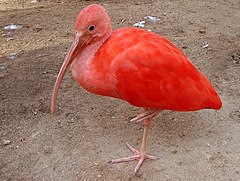Eudocimus – Wikipedia, wolna encyklopedia
| Eudocimus[1] | |||
| Wagler, 1832[2] | |||
 Przedstawiciel rodzaju – ibis szkarłatny (E. ruber) | |||
| Systematyka | |||
| Domena | |||
|---|---|---|---|
| Królestwo | |||
| Typ | |||
| Podtyp | |||
| Gromada | |||
| Podgromada | |||
| Infragromada | |||
| Rząd | |||
| Podrząd | |||
| Rodzina | |||
| Rodzaj | Eudocimus | ||
| Typ nomenklatoryczny | |||
| Scolopax rubra Linnaeus, 1758 | |||
| Synonimy | |||
| |||
| Gatunki | |||
| |||
| Zasięg występowania | |||
 - ibis biały (Eudocimus albus) - ibis szkarłatny (Eudocimus ruber) - występowanie obu gatunków | |||
Eudocimus – rodzaj ptaków z rodziny ibisów (Threskiornithidae).
Zasięg występowania
[edytuj | edytuj kod]Rodzaj obejmuje gatunki występujące w Ameryce[5].
Morfologia
[edytuj | edytuj kod]Długość ciała 56–71 cm; masa ciała samic 593–901 g, samców 810–1261 g[5].
Systematyka
[edytuj | edytuj kod]Etymologia
[edytuj | edytuj kod]- Eudocimus: gr. ευδοκιμος eudokimos „wspaniały”, od ευ eu „ładny, dobry”; δοκιμος dokimos „doskonały, szacowny”, od δεχομαι dekhomai „aprobować”[6].
- Guara: tupí Guará „ptak”[6]. Gatunek typowy: Scolopax rubra Linnaeus, 1758.
- Leucibis: gr. λευκος leukos „biały”; ιβις ibis, ιβιδος ibidos „ibis”[6]. Gatunek typowy: Scolopax alba Linnaeus, 1758.
- Paribis: gr. παρα para „blisko”; rodzaj Ibis Lacépède, 1799[6]. Gatunek typowy: Scolopax rubra Linnaeus, 1758.
Podział systematyczny
[edytuj | edytuj kod]Do rodzaju należą następujące gatunki[7]:
- Eudocimus albus (Linnaeus, 1758) – ibis biały
- Eudocimus ruber (Linnaeus, 1758) – ibis szkarłatny
Przypisy
[edytuj | edytuj kod]- ↑ Eudocimus, [w:] Integrated Taxonomic Information System (ang.).
- ↑ J.G. Wagler. Neue Sippen und Gattungen der Säugthiere und Vögel. „Isis von Oken”. 1832, s. 1232, 1832. (niem.).
- ↑ a b H.G.L. Reichenbach: Avium systema naturale. Das natürliche system der vögel mit hundert tafeln grösstentheils original-abbildungen der bis jetzt entdecken fast zwölfhundert typischen formen. Vorlaüfer einer iconographie der arten der vögel aller welttheile. Dresden und Leipzig: Expedition der vollständigsten naturgeschichte, 1850, s. xiv. (niem.).
- ↑ J.E.M. Le Maout: Histoire naturelle des oiseaux: suivant a classification de M. Isidore Geoffroy-Saint-Hilaire, avec l’indication de leurs moeurs et de leurs rapports avec les arts, le commerce et l'agriculture. Paris: L. Curmer, 1853. (fr.).
- ↑ a b D.W. Winkler, S.M. Billerman & I.J. Lovette: Ibises and Spoonbills (Threskiornithidae), version 1.0.. W: S.M. Billerman, B.K. Keeney, P.G. Rodewald & T.S. Schulenberg (red.): Birds of the World. Ithaca, NY: Cornell Lab of Ornithology, 2020. DOI: 10.2173/bow.thresk1.01. [dostęp 2020-05-28]. (ang.).

- ↑ a b c d Etymologia za: The Key to Scientific Names, J.A. Jobling (red.), [w:] Birds of the World, S.M. Billerman et al. (red.), Cornell Lab of Ornithology, Ithaca (ang.).
- ↑ Systematyka i nazwy polskie za: P. Mielczarek & M. Kuziemko: Rodzina: Threskiornithidae Poche, 1904 - ibisy - Ibises (Wersja: 2019-10-12). [w:] Kompletna lista ptaków świata [on-line]. Instytut Nauk o Środowisku Uniwersytetu Jagiellońskiego. [dostęp 2020-02-23].


 French
French Deutsch
Deutsch